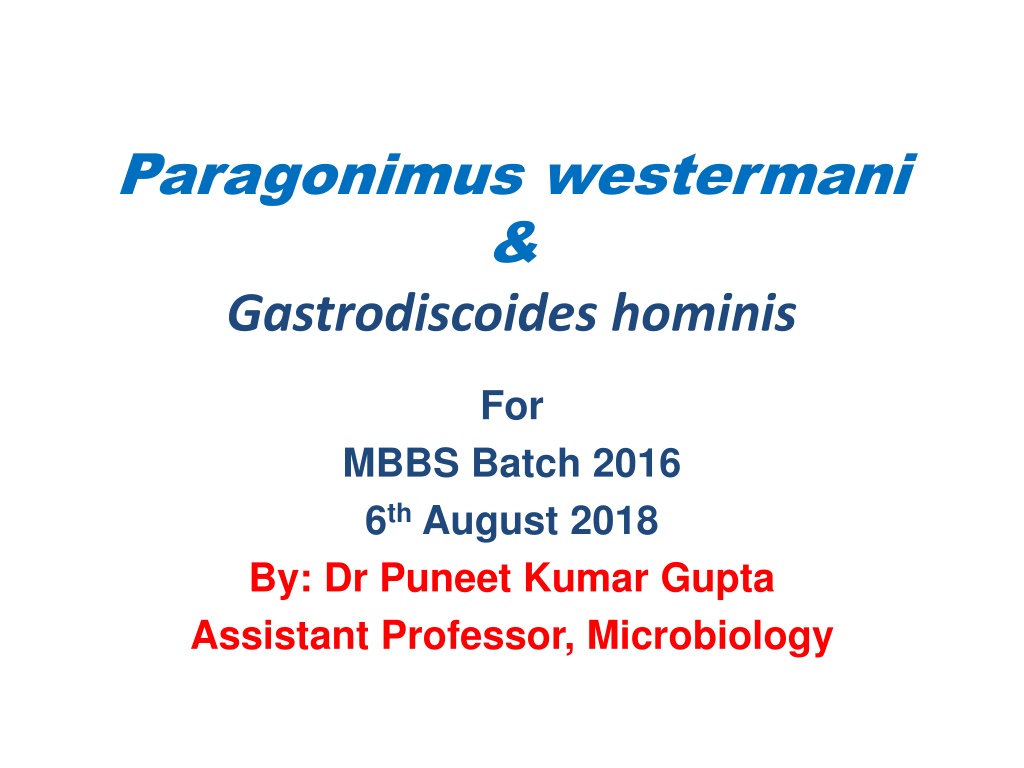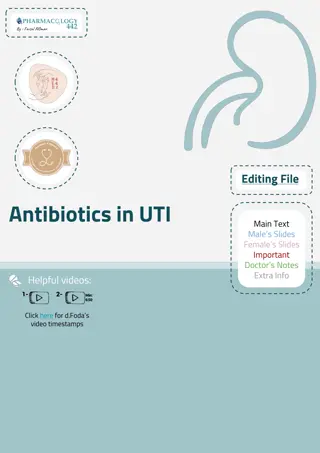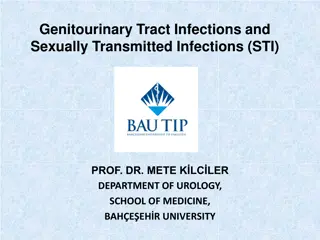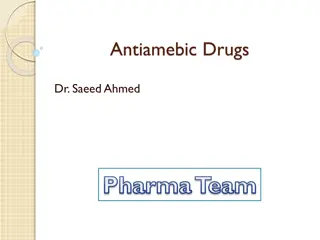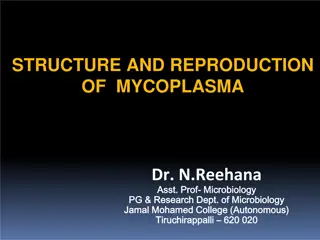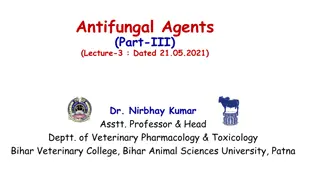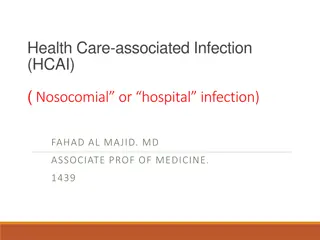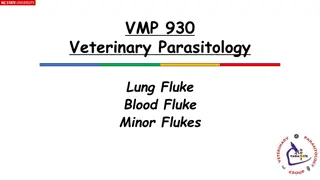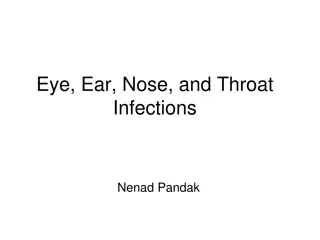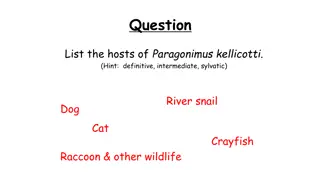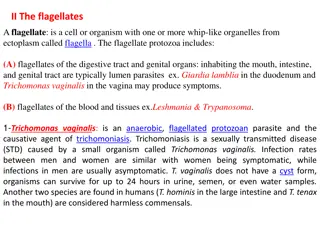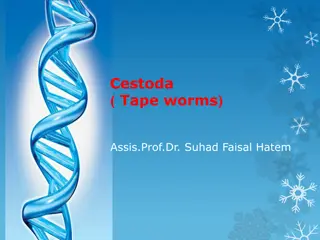Understanding Paragonimus westermani and Gastrodiscoides hominis Infections
Paragonimus westermani and Gastrodiscoides hominis are parasitic flatworms that infect humans primarily through the consumption of raw or undercooked crabs and crayfish. They can cause serious respiratory and CNS complications. The adult worms have distinct morphological characteristics and a complex life cycle involving three hosts. Proper cooking of seafood is essential to prevent infection.
Download Presentation

Please find below an Image/Link to download the presentation.
The content on the website is provided AS IS for your information and personal use only. It may not be sold, licensed, or shared on other websites without obtaining consent from the author. Download presentation by click this link. If you encounter any issues during the download, it is possible that the publisher has removed the file from their server.
E N D
Presentation Transcript
Paragonimus westermani & Gastrodiscoides hominis For MBBS Batch 2016 6thAugust 2018 By: Dr Puneet Kumar Gupta Assistant Professor, Microbiology
Oriental Lung fluke (flatworm) Infects lungs of humans after eating an infected raw or undercooked crab or crayfish Less frequent, but more serious cases when parasite travels to CNS >30 Species-Infect human & Animals >10 -----------Infect humans 10/1/2024 2
P. westermani (MC), Primarily in Asia including China, Philippines, Japan, Vietnam, South Korea, Taiwan, &Thailand India (Assam, Bengal, South India) P. africanus-Africa P. mexicanus - Central & South America shellfish consumed raw or prepared only in vinegar, brine, or wine without cooking Raw crabs or crayfish -used in traditional medicine practices in Korea, Japan, and some parts of Africa P. kellicotti-Rare- US (Midwest) ingestion of uncooked crawfish during river raft float trips in Missouri. 10/1/2024 3
Morphology Adult worm: Egg shaped Ant end broad> post end 8-12 X 4-6 X 3-5 mm (L X B X Thickness) Ventral Sucker Middle of body Life span: 6-7 yrs Habitat: Respiratory tract (Lungs) 10/1/2024 4
Morphology Egg: Golden brown Oval with flattened opercula 80 X 55 m Unsegmented ovum surrounded by yolk sac 10/1/2024 5
Life cycle 3 hosts 1 Definitive: Man & Domestic animals Usual host Asia: Tiger & lepord Reservoir: Feline 2 Intermediate: Fresh water Snail: Melania Fresh water crayfish or crab 10/1/2024 6
Pathogenicity Mode of infection Eating raw/improper cooked flesh of infected crayfish/crab Drunken crab: Strips of raw crab meat soaked in alcohol Infective stage: Metacercaria (adolescaria inside a cyst) Portal of Entry: Digestive tract Site of Localization: Lungs 10/1/2024 9
Disease No symptom with light infection Pulmonary Paragonimiasis: Acute syndrome with cough, abdominal pain, discomfort & low-grade fever occur 2 to 15 days after infection Long-term infection may mimic bronchitis, bronchiectasis or tuberculosis with Chronic cough with recurrent bout of blood- tinged sputum 10/1/2024 10
Disease Coffee-colored or blood-tinged sputum, often accompanied by chest pain and/or shortness of breath sputum clumps of eggs Peripheral eosinophilia- early larval migration stages intense CXR: lobar infiltrates, coin lesions, cavities, calcified nodules, hilar enlargement, pleural thickening & effusions 10/1/2024 11
Disease Ring-shaped opacities of contiguous cavities - bunch of grapes -highly suggestive of pulmonary paragonimiasis 10/1/2024 12
Disease Extrapulmonary paragonimiasis: CNS disease grapebunch findings, temporal & occipital lobes on CT brain CNS involvement 25% of hospitalized patients may be associated with Paragonimus-induced meningitis. symptoms -headaches, seizures, and visual disturbances 10/1/2024 13
Disease Ectopic lesions Aberrant migration of flukes -any organ, including abdominal viscera, heart & mediastinum Liver, spleen, intestinal wall, peritoneum, and abdominal LN & skin Cerebral -highly endemic countries-children Eosinophilic meningoencephalitis, seizures, or signs of space-occupying lesions 10/1/2024 14
Diagnosis Eggs: Sputum, Stool M/E Destroyed by ZN Stain Yellowish brown 80-120 m long X 45-70 m wide thick-shelled with an obvious Shouldered operculum D/d D. latum egg: Devoid of shoulder Knoblike protrusion at other end (Absent in P. westermani) 10/1/2024 15
10/1/2024 16
Diagnosis Serologic tests useful for early infections (prior to maturation of flukes) or for ectopic infections where eggs are not passed in stool IHA & ELISA Test negative 3-4 months after successful treatment Intradermal Test: Epidemiological Help Immediate hypersensitivity test Remains + ve long after recovery Indicate past infection 10/1/2024 17
Diagnosis Complement fixation test Positive in Active infection Test negative soon after death of worm Radiology X ray: Abnormal Shadow (Nodular/cystic, Infiltrative) in middle or lower lung field Presence of shadow of tunnels & burrows in lung CT PCR: Research use 10/1/2024 18
Diagnosis Patient with CNS disease also have pulmonary infections Trematode larva migrans: P. skrjabini often produces skin nodules, subcutaneous abscesses, or a type of creeping eruption reatment 10/1/2024 19
Treatment DOC: Praziquantel: 5 mg/kg Per oral TDS X 2d Alternative: Triclabendazole: 10 mg/kg Per oral OD or BD For cerebral disease: Additional a short course of corticosteroids to reduce inflammatory response around dying flukes Triclabendazole: CDC Not in United States (Not approved by FDA) 10/1/2024 20
Prevention & Control Never eat raw freshwater crabs or crayfish Cook crabs & crayfish for to at least 145 F (~63 C) Travelers advised to avoid traditional meals containing undercooked freshwater crustaceans 10/1/2024 21
Gastrodiscoides hominis Caecum: 1st reported in Indian patient suffering from Diarrhoea India: Assam, Bengal, Bihar, Orissa Vietnam, Phillippines 10/1/2024 22
Morphology Adult worm: Pyriform shaped Ant end Conical post end Hemispherical 5-10 X 4-6 mm Bright pinkish color Ventral Sucker Large intestine (Caecum & Ascending Colon of definitive host: Man, pigs, monkey , rodents) Pig & Monkey: Reservoir 10/1/2024 23
Morphology Egg: Greenish brown ovoid Operculated 150 X 60-70 m Immature when laid 10/1/2024 24
Life cycle Egg---- Passed in faceces infect water- -Miracidium metacercariae in Vegatation & Snail Penetrate aquatic gastropod Mollusc Rediae Cercariae Sporocyst 10/1/2024 25
Disease Mucous diarrhoea & Oedema of intestinal wall: worm attachment to caecum & ascending colon with help of Large sucker 10/1/2024 26
Diagnosis Eggs D/d F. buski and F. hepatica (130-150 X 60-90 m) Gastrodiscoides hominis may be slightly larger (130-160 micrometers 10/1/2024 27
Thank you 10/1/2024 28
10/1/2024 29
